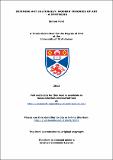Files in this item
Defining art culturally : modern theories of art - a synthesis
Item metadata
| dc.contributor.advisor | Gaut, Berys Nigel | |
| dc.contributor.author | Fokt, Simon | |
| dc.coverage.spatial | 226 | en_US |
| dc.date.accessioned | 2013-06-12T15:15:44Z | |
| dc.date.available | 2013-06-12T15:15:44Z | |
| dc.date.issued | 2013-06-27 | |
| dc.identifier.uri | https://hdl.handle.net/10023/3675 | |
| dc.description.abstract | Numerous theories have attempted to overcome the anti-essentialist scepticism about the possibility of defining art. While significant advances have been made in this field, it seems that most modern definitions fail to successfully address the issue of the ever-changing nature of art raised by Morris Weitz, and rarely even attempt to provide an account which would be valid in more than just the modern Western context. This thesis looks at the most successful definitions currently defended, determines their strengths and weaknesses, and offers a new, cultural definition which can preserve the good elements of other theories, solve or avoid their problems, and have a scope wide enough to account for art of different times and cultures. The resulting theory is a synthetic one in that it preserves the essential institutionalism of Dickie's institutional views, is inspired by the historical and functional determination of artistic phenomena present in Levinson's historicism and Beardsley's functionalism, and presents the reasons for something becoming art in a disjunctive form of Gaut's cluster account. Its strengths lie in the ability to account for the changing art-status of objects in various cultures and at various times, providing an explanation of not only what is or was art, but also how and why the concept 'art' changes historically and differs between cultures, and successfully balancing between the over-generalisations of ahistorical and universalist views, and the uninformativeness of relativism. More broadly, the cultural theory stresses the importance of treating art as a historical phenomenon embedded in particular social and cultural settings, and encourages cooperation with other disciplines such as anthropology and history of art. | en_US |
| dc.language.iso | en | en_US |
| dc.publisher | University of St Andrews | |
| dc.rights | Creative Commons Attribution-NonCommercial-NoDerivs 3.0 Unported | |
| dc.rights.uri | http://creativecommons.org/licenses/by-nc-nd/3.0/ | |
| dc.subject | Definition of art | en_US |
| dc.subject | Aesthetics | en_US |
| dc.subject.lcc | BH39.F7 | |
| dc.subject.lcsh | Arts--Philosophy | en_US |
| dc.subject.lcsh | Arts and society | en_US |
| dc.subject.lcsh | Aesthetics | en_US |
| dc.title | Defining art culturally : modern theories of art - a synthesis | en_US |
| dc.type | Thesis | en_US |
| dc.contributor.sponsor | Arts and Humanities Research Council (AHRC) | en_US |
| dc.type.qualificationlevel | Doctoral | en_US |
| dc.type.qualificationname | PhD Doctor of Philosophy | en_US |
| dc.publisher.institution | The University of St Andrews | en_US |
This item appears in the following Collection(s)
Except where otherwise noted within the work, this item's licence for re-use is described as Creative Commons Attribution-NonCommercial-NoDerivs 3.0 Unported
Items in the St Andrews Research Repository are protected by copyright, with all rights reserved, unless otherwise indicated.


